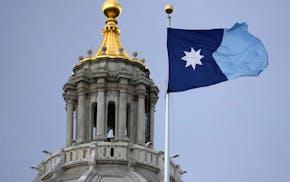The analysis of Tuesday's election results up and down the ballot will continue for years. Here are some takeaways from Minnesota, which voted for Democrat Kamala Harris and Gov. Tim Walz:
Strong voter turnout
The Secretary of State's Office estimates 76% of eligible Minnesota voters cast ballots this year. Secretary of State Steve Simon said Monday that he hoped Minnesota was on track to once again lead the nation in voter turnout, after Maine took that honor in 2022.
Early indications are that Minnesota is competing for the honor with Wisconsin and Colorado this year.
More than 1.2 million Minnesotans cast their ballots before Election Day, nearly double the previous record for a nonpandemic election set in 2016. Four years ago with the pandemic raging, 1.9 million people voted early that year. In that presidential election, 3.2 million Minnesotans voted, a turnout of just under 80%.
Over the previous 12 presidential elections, Minnesota has ranked No. 1 in voter turnout nine times and second three times, losing to Maine on each occasion, according to a report from the New Hampshire secretary of state.
Congressional incumbents won big
All seven Minnesota incumbents in the U.S. House easily won re-election.
U.S. Rep. Ilhan Omar had the widest margin of victory, not surprising given that she represents the deep blue Minneapolis-centered Fifth Congressional District. She defeated GOP challenger Dalia Al-Aqidi with 74% of the vote.
The closest contest was in the competitive Second Congressional District between Rep. Angie Craig and GOP challenger Joe Teirab. The two had a 13% gap with 55% for Craig and 42% for Teirab.
In the only open seat, the west suburban Third Congressional District, former state Sen. Kelly Morrison trounced former legislator and retired Washington County judge Tad Jude, 58% to 41%.
Also easily winning re-election: Republican Reps. Tom Emmer, Brad Finstad, Michelle Fischbach and Pete Stauber, along with Democratic Rep. Betty McCollum.
Judicial incumbents prevail
The races are nonpartisan. The candidates don't talk about issues or cases and they can't raise money for themselves. But most are unopposed and the word "incumbent" appears next to the names of sitting judges on the ballot, which appeared to be an advantage given the results.
Supreme Court Chief Justice Natalie Hudson stood for election as chief for the first time and easily overcame her challenger. This will likely be her final judicial election as Hudson will hit the mandatory judicial retirement age of 70 in January 2027.
Justice Karl Procaccini, appointed to the high court in August 2023, faced his first election, defeating Matthew Hanson, a lawyer who previously challenged a District Court incumbent. Procaccini won 57% to 43%.
Justice Anne McKeig was also on the ballot without opposition. The justices serve four-year terms.
In her first election, Washington County Judge Helen Brosnahan staved off a challenge from lawyer Nathan Hansen, who was the Republican recommended candidate.
Klobuchar won, but her popularity and coattails shrank
U.S. Sen. Amy Klobuchar defeated bombastic GOP challenger Royce White 56% to nearly 41%. She outperformed the Harris-Walz ticket by 5 percentage points. Still, Klobuchar's margin was smaller than her 60% to 36% win over Republican Jim Newberger in 2018. White flipped 29 rural counties that Klobuchar carried six years ago.
In 2012, Klobuchar also outperformed President Barack Obama by more than 308,000 votes. That year, she won all but two of the state's 87 counties. Obama won just 28 counties. In 2018, she won 51 counties.
In 2006, a nonpresidential election, Klobuchar won all but eight counties in her first campaign for U.S. Senate.
Her coattails are shrinking. In previous years when Klobuchar was up for election, DFL state House candidates collected more votes overall statewide. This year, DFL candidates got 49.95% of the vote statewide. That was down from 50.91% in 2022 when Klobuchar wasn't on the ballot. In 2018, the last time Klobuchar was on the ballot, DFL candidates got 54.4% of the vote.
Minnesotans really like the outdoors
Millions will continue to flow from the Minnesota State Lottery to the environment. A ballot question on whether to continue the dedicated lottery funding required more than 50% of the vote. It got much more. About 77% of voters agreed to continue sending the cash to the great outdoors at least through 2050.
Since voters adopted dedicated lottery funding for the outdoors in 1988, the pipeline of money has provided tens of millions of dollars a year for clean water, wildlife habitat, environmental education, trails, land acquisition and other projects beneficial to natural resources.
"This goes to show that people can still agree on clean water and the environment, no matter what your politics are,'' said Michelle Stockness, executive director of Freshwater, a St. Paul-based nonprofit. "We're lucky to have a fund like this and other states would love to have it.''
Carnahan's comeback in cabin country
Former Minnesota GOP Chair Jennifer Carnahan's political comeback is underway as she defeated incumbent Nisswa Mayor John Ryan by 10 percentage points. Nisswa has a weak-mayor system, meaning Carnahan will provide the tie-breaking vote on council actions. The job pays $350 a month.
Carnahan was forced out as state GOP chair in 2021 amid a scandal and allegations that she had created a toxic work environment.
Kim Hyatt, Tony Kennedy and Tom Nehil contributed to this report.
Wildfire smoke extends Minnesota air-quality alert through Wednesday morning
Minneapolis Council Vice President Chughtai fails to win DFL endorsement; assault allegations fly

A 23-year-old woman was killed in 'war zone' shooting at Minneapolis' Boom Island park

